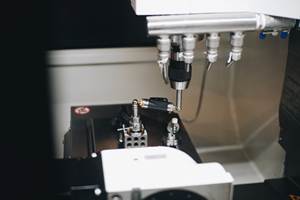Feels Like A Go To Me
Once a QC manager came to me, confused and dissatisfied. He was spending money to buy quality masters, but his inspection process was not improving.
Share





Once a QC manager came to me, confused and dissatisfied. He was spending money to buy quality masters, but his inspection process was not improving. Plus, his masters went out of calibration rapidly, pushing costs even higher. The problem was that he was buying more accuracy than he could use.
Choosing the right tool for the job is as important to mastering as to other areas of gaging. It may be possible to master a gage using a variety of standards, but the best master for a job has a balance between accuracy, economy, durability and ease of use.
Gage blocks are "primary standards" traceable to an "absolute" standard maintained by NIST, DIN or ISO. Masters are "secondary" standards; their sizes are established by reference to primary standards. Masters typically have a higher level of uncertainty, but they are often the right choice for production gaging. Gage blocks are square, while masters are often round. If the parts being measured are round and the gage is designed to measure round parts, the use of a round master will help avoid geometry error.
A master ring or ring gage is basically a bore of a known dimension. The same device can often be used as a setting master for variable inside-diameter gages (such as bore gages, air tooling and mechanical plug gages), for go/no-go mastering of fixed ID gages and for go/no-go OD inspection of male cylindrical workpieces.
Ring gages are made from steel, chromed steel for durability and corrosion resistance, or tungsten carbide for extreme wear resistance. They are classed by level of accuracy, with XXX indicating the tightest tolerances; XX, X and Y being intermediate grades; and Z being the lowest. Class tolerances vary by size: Larger sizes have higher levels of uncertainty. Tolerances may be bilateral for use in setting variable gages or unilateral for use as go/no-go gages. For rings, "go" is minus; for plugs, plus. Go/no-go gages may often be identified by a groove or ring on their knurled outside diameters.
Plug gages, for go/no-go measurements of part IDs or for mastering ID gages, are also available in different materials and classes. Plug gages may be reversible or double ended, with a "go" end signified by a green stripe and a "no go" end signified by a red stripe. Usually available only in sizes up to about 0.76", reversible plug gages can be disassembled to replace a worn end.
Plug gages are identified by the names of their handle or mounting designs. Taper-lock plug gages usually range from 0.059" to 1.510" and have a handle on one end. Tri-lock designs, also called discs, range from 1.510" to 8.010" and have handles on both ends. Annular designs, for sizes from 8.010" to 12.010", are like wagon wheels, with handles for axles.
Specialty masters are available for a range of applications and shapes, including slots, splines and tapers. Tool holder taper geometry is important in precision machining, and manufacturers are paying attention to taper quality. Taper plug gages can indicate if an ID taper is too steep or too shallow, or if the bore entry diameter is within tolerances. Inside and outside taper masters are used for setting taper air gaging. Such special-purpose masters make mastering and measuring quicker and easier, and they usually cost more.
Choose a master whose tolerance is 10 percent of the precision of the gage. The gage's precision and repeatability should be 10 percent of the part tolerance. It's usually not worthwhile to buy more accuracy than this "ten to one" rule: It costs more, it doesn't improve the accuracy and the master will lose calibration faster. On the other hand, when manufacturing to extremely tight tolerances, one might need a ratio of 4:1 or even 3:1 between gage and standard.
Here are some general guidelines for the care and feeding of masters: Store them in a secure place; use a wax- or oil-based sealant to protect against corrosion; handle carefully—don't force or jam them onto the part; don't try to modify them; and when shipping for calibration, take steps to protect masters against damage and corrosion.
Related Content
Ballbar Testing Benefits Low-Volume Manufacturing
Thanks to ballbar testing with a Renishaw QC20-W, the Autodesk Technology Centers now have more confidence in their machine tools.
Read MoreThe Many Ways of Measuring Thickness
While it may seem to be a straightforward check, there are many approaches to measuring thickness that are determined by the requirements of the part.
Read MoreOrthopedic Event Discusses Manufacturing Strategies
At the seminar, representatives from multiple companies discussed strategies for making orthopedic devices accurately and efficiently.
Read More6 Machine Shop Essentials to Stay Competitive
If you want to streamline production and be competitive in the industry, you will need far more than a standard three-axis CNC mill or two-axis CNC lathe and a few measuring tools.
Read MoreRead Next
AMRs Are Moving Into Manufacturing: 4 Considerations for Implementation
AMRs can provide a flexible, easy-to-use automation platform so long as manufacturers choose a suitable task and prepare their facilities.
Read MoreLast Chance! 2025 Top Shops Benchmarking Survey Still Open Through April 30
Don’t miss out! 91ÊÓƵÍøÕ¾ÎÛ's Top Shops Benchmarking Survey is still open — but not for long. This is your last chance to a receive free, customized benchmarking report that includes actionable feedback across several shopfloor and business metrics.
Read MoreMachine Shop MBA
Making Chips and 91ÊÓƵÍøÕ¾ÎÛ are teaming up for a new podcast series called Machine Shop MBA—designed to help manufacturers measure their success against the industry’s best. Through the lens of the Top Shops benchmarking program, the series explores the KPIs that set high-performing shops apart, from machine utilization and first-pass yield to employee engagement and revenue per employee.
Read More



















